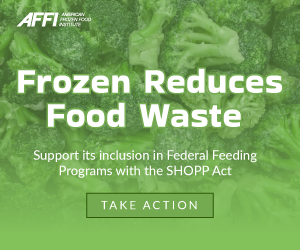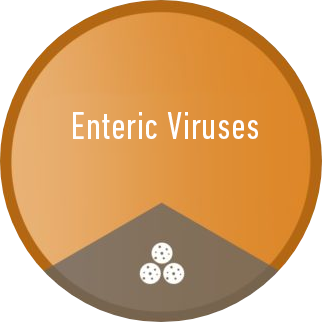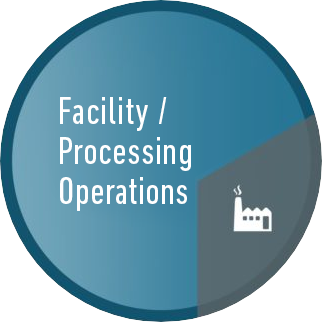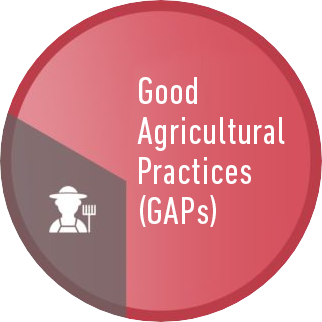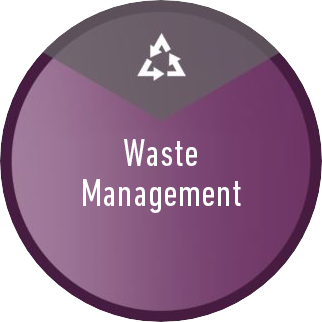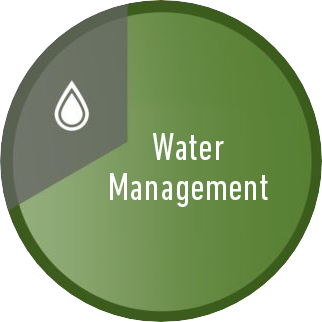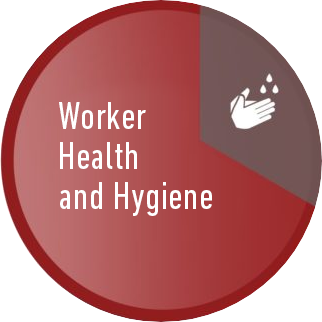Worker Health and Hygiene
Worker Health and Hygiene
Among the most significant efforts to prevent introduction of enteric viruses in frozen food facilities is commitment to employee health and implementation of good hygienic practices. This section includes training materials, hygiene hazard assessments, and resources to address hygiene and food handling practices that can prevent potential infection among employees and food contamination.
Post-harvest: Resource materials include management of personnel, proper clean-up and disinfection methods, and food handling education and training materials.
Worker Health and Hygiene Recommendations
Recommendations
To download these free resources, please login as an AFFI member or create a non-member profile first.
Children and Babies in the Farm
Pre-Harvest
According to WHO, children under the age of six that may be infected with enteric viruses do not typically experience noticeable symptoms. Young children, infants, and babies should therefore not be allowed in the farm areas as they pose the risk of spreading Hepatitis A or Norovirus infections or contaminating food 1. Ensure that young children, infants, and babies are not present on the fields.
Children, Infants and Babies on the Farm
Harvest
Young children, infants, and babies may be infected with enteric viruses and be asymptomatic, and may pose the risk of spreading Hepatitis A or Norovirus infections or contaminating food
1. Ensure that young children, infants, babies and pets are prohibited from entering the fields during harvesting.
Cleaning and Sanitation of Harvesting Tools and Containers
Harvest
Harvesting equipment (tools, packaging, containers, etc.) can all be sources of contamination
1. Harvesting equipment (tools, packaging, containers, etc.) can all be sources of contamination
2. For reusable containers, packaging and tools, the material and design should be easy to clean, maintain and appropriate for their intended use
Cleaning and Sanitation of Tools
Post-Harvest
Tools, utensils and other implements in the facility can cross contaminate harvested fruits
1. All tools, utensils, cloths and sponges used to clean raw fruits or food contact surfaces should be cleaned and sanitized at least daily.
2. If organic matter builds up on sponges and cloths or if they appear to be contaminated, they should be immediately discarded and replaced prior to cleaning operations.
Communal and Seasonal Housing of Workers
Harvest
Management may provide worker housing, if so, these accommodations should ensure hygienic living conditions
1. All on-farm living quarters should meet habitable standards (sound roof, windows and doors)
2. Basic amenities such as drinking water, good ventilation, and bathroom facilities with adequate drains
3. In the event drains are not possible in bathrooms, septic pits that are compliant with local regulations may be utilized.
Employee Training
Pre-Harvest
Improper personal hygiene practices in restrooms and bathrooms present a significant risk of spreading enteric virus infection and contaminating food 1. Train and reinforce the importance of using bathroom facilities prior to harvesting activities. 2. Ensure all bathrooms are clean and in hygienic condition 3. Ensure sufficient sanitation stations are available within a reasonable proximity to work areas in the field to encourage field workers to follow hygiene policies.
Farm and Facility Vehicles
Post-Harvest
Facility Transportation Storage
1. Farm vehicles, pallets, containers or bins used to transport harvested produce and/or packed products are cleaned and maintained to prevent contamination (e.g. soil, dirt, animal manure, spills, etc.)
2. Protect unused clean and new packing containers from contamination while in storage.
Health and Hygiene Information
Post-Harvest
Health and Hygiene Training
1. Signs with the key hygiene instructions should be visibly displayed in relevant locations.
2. Clear instructions must be shared to ensure all workers wash hands before handling raw fruit.
3. In general, all workers handling ready-to-eat products are expected to wash hands prior to start of work, after each visit to a toilet, after handling contaminated material, after smoking or eating (in designated areas), after breaks, and at any other time when their hands may have been exposed to potential contamination.
Locker Room Management
Post-Harvest
Management should provide designated rooms for changing clothes
1. All employees should use these facilities to change clothing and any protective outer garments as needed.
Managing Sick/Ill Persons and Employees
Harvest
Precluding sick employees from coming to work prevents the potential for food and surface contamination
1. Sick or injured employees should not be allowed to work on tasks that may contaminate the fruits or food contact surfaces
2. Do not let any sick or injured employee harvest fruits even if the employee is protected with mask and gloves.
Monitoring Employee Health
Pre-Harvest
Monitoring employee health conditions, especially prior to harvest, helps preclude sick employees from coming to work and potentially infecting other employees and contaminating food
1. Farm management should incorporate active health monitoring systems.
2. Operations should develop a detailed employee health monitoring procedure.
3. All health monitoring activities should be documented and stored for easy retrieval
Procesing Equipment
Post-Harvest
Facilities should allocate specific packing and processing areas comprised of appropriate equipment
1. The packing area and equipment that come in contact with fruits should be cleaned and sanitized at least daily.
Processing Facility and Infrasctructure
Post-Harvest
Infrastructure needed for packing and processing of fruits
Guide to Minimize Microbial Food Safety Hazards (FDA)
Maintenance and Repair of Buildings (CanadaGAP)
Cleaning and Maintenance of Hygiene Facilities (CanadaGAP)
Cleaning and Maintenance of Hygiene Facilities Log (CanadaGAP)
1. The facility for packing or collection of fruits should be of adequate size and allow cleaning and disinfection.
2. The facility should be designed to prevent accumulation of water on the floor and avoid leaking.
Sanitation in Farms and Processing Facilities
Harvest
Harvest workers should have access to clean sanitation facilities
1. Provide potable water, and ample hand washing stations that are inside bathrooms or near toilet facilities.
2. Ensure workers wash hands properly with soap or other effective surfactant and running potable water
3. Do not provide or allow the use of hand sanitizer as a substitute for soap and water.
Testing of Food Contact Surfaces
Harvest
Swab food contact surfaces and test for bacterial indicators (such as E. coli, fecal coliform or total coliform) at least on the first day of harvesting and in the middle of the season. When test results indicate fecal contamination, test for enteric viruses including Hepatitis A virus (HAV) and Norovirus (NoV). If virus is detected, reinforce surface disinfection, repeat test to confirm contamination, and isolate affected surfaces until the contamination is removed.
Testing of Food Contact Surfaces
Post-Harvest
Swab food contact surfaces and test for bacterial indicators (such as E. coli, fecal coliform or total coliform) at least once a month during production. When test results indicate fecal contamination, test for Hepatitis A virus (HAV) and Norovirus (NoV). If virus is detected, reinforce surface disinfection, repeat test to confirm contamination, and isolate affected surfaces until the contamination is removed.
Testing of Fruit
Harvest
Test harvested fruits for Hepatitis A virus (HAV) and Norovirus (NoV) at least once per season or if other fruit test results indicate fecal contamination. If virus is detected, stop harvesting, repeat test to confirm the contamination and reinforce sanitation activities. Do not consume or distribute the contaminated fruit.
Testing of Fruits
Post-Harvest
Test finished products for Hepatitis A virus (HAV) and Norovirus (NoV) at least once per month during production. If virus is detected, isolate affected lot(s) and repeat test to confirm the scope of contamination. Do not consume or distribute the affected lot(s). Discard or dispose the fruit according to regulatory requirement or internal protocols.
Testing of Workers Hands
Post-Harvest
Swab plant workers’ hands and test for bacterial indicators (such as E. coli, fecal coliform or total coliform) every 2 months without prior notice. When test results indicating fecal contamination, test for Hepatitis A virus (HAV) and Norovirus (NoV). If virus is detected, temporarily remove the person affected from positions requiring direct contact with food, verify the health condition of the person and repeat test to confirm the infection. If viral infection is confirmed, the plant worker shall not return to work until NoV and/or HAV infection is confirmed negative. Consider increase the number and frequency of test if virus is detected repetitively.
Testing of Workers Hands
Harvest
Swab hands of harvesters or other farm workers in direct contact with fruit and test for bacterial indicators (such as E. coli or fecal coliform) at least on the first day of harvesting and in the middle of the season. When test results indicate fecal contamination, test for Hepatitis A virus (HAV) and Norovirus (NoV). If virus is detected, remove the person temporarily from positions requiring direct contact with food, verify the health condition of the person and repeat test to confirm the infection. If viral infection is confirmed, the person shall not return to work until NoV and/or HAV infection is confirmed negative. Consider increase the number and frequency of test if virus is detected repetitively.
Training Team Leader
Pre-Harvest
Designated Training Team and Leader 1. Management should assign a specific group of competent individuals and a team leader such as a farm manager with the responsibility of implementing proper hygiene practices among workers and visitors.
Worker Behaviors on the Field
Harvest
It is good hygienic practice to avoid smoking, eating, chewing or drinking during harvesting operations
1. Smoking, eating, chewing, and drinking should be confined only to designated areas and away from crops
2. Smoking, eating, chewing, and drinking should not be permitted in the fruit handling or storage areas, unless indicated otherwise by an extensive hygiene risk assessment (drinking water can be an exception)
Worker Health and Hygiene Training
Pre-Harvest
Worker Health and Hygiene Training Requirements
Employee Hygiene and Health Training (AFFI)
Guide to Minimize Microbial Food Safety Hazards (FDA)
Worker Hygiene Assessment and Training (AFFI)
Worker Health and Hygiene Library (AFFI)
1. Provide annual training to all farm workers regarding the hygiene procedures to be followed during harvesting and product handling activities.
Worker Health and Hygiene and Food Safety Training
Harvest
Worker health and hygiene training and food safety training is a critical component of preventing enteric virus contamination during harvesting
1. All staff, supervisors, and temporary workers handling fruits should be trained at the time of hiring and at least once a year about food safety, hygiene practices and infectious diseases
2. All workers should be able to distinguish between contaminated or potentially contaminated fruits, fecal matter, traces of animal/insect body parts, damaged plants or fruits, and the discern general cleanliness of harvesting tools and containers.
3. Establish a verification program for good handling practices during harvesting
Worker Health and Hygiene Hazard Assessment
Pre-Harvest
Health and Hygiene Hazard Assessment in the Farm 1. Conduct and record a hygiene hazard assessment covering physical, chemical (incl. allergens) and microbiological contaminants, spillage of bodily fluids (e.g.: vomiting, bleeding), and human transmissible diseases, customized to the products and processes.
Worker Health and Hygiene Training Methods
Worker Health and Hygiene Training 1. Workers should be trained using written documents and infographics to outline how workers can prevent physical (e.g. snails, stones, insects, knives, fruit residues, watches, mobile phones, etc.), microbiological and chemical contamination of the product during harvesting. 2. Education and training materials should be provided in multiple languages to meet worker needs.


